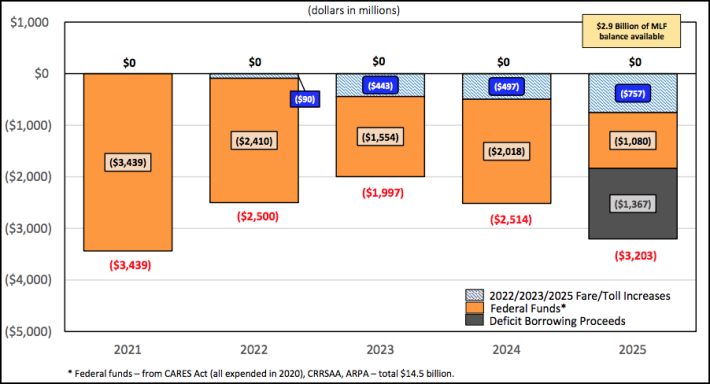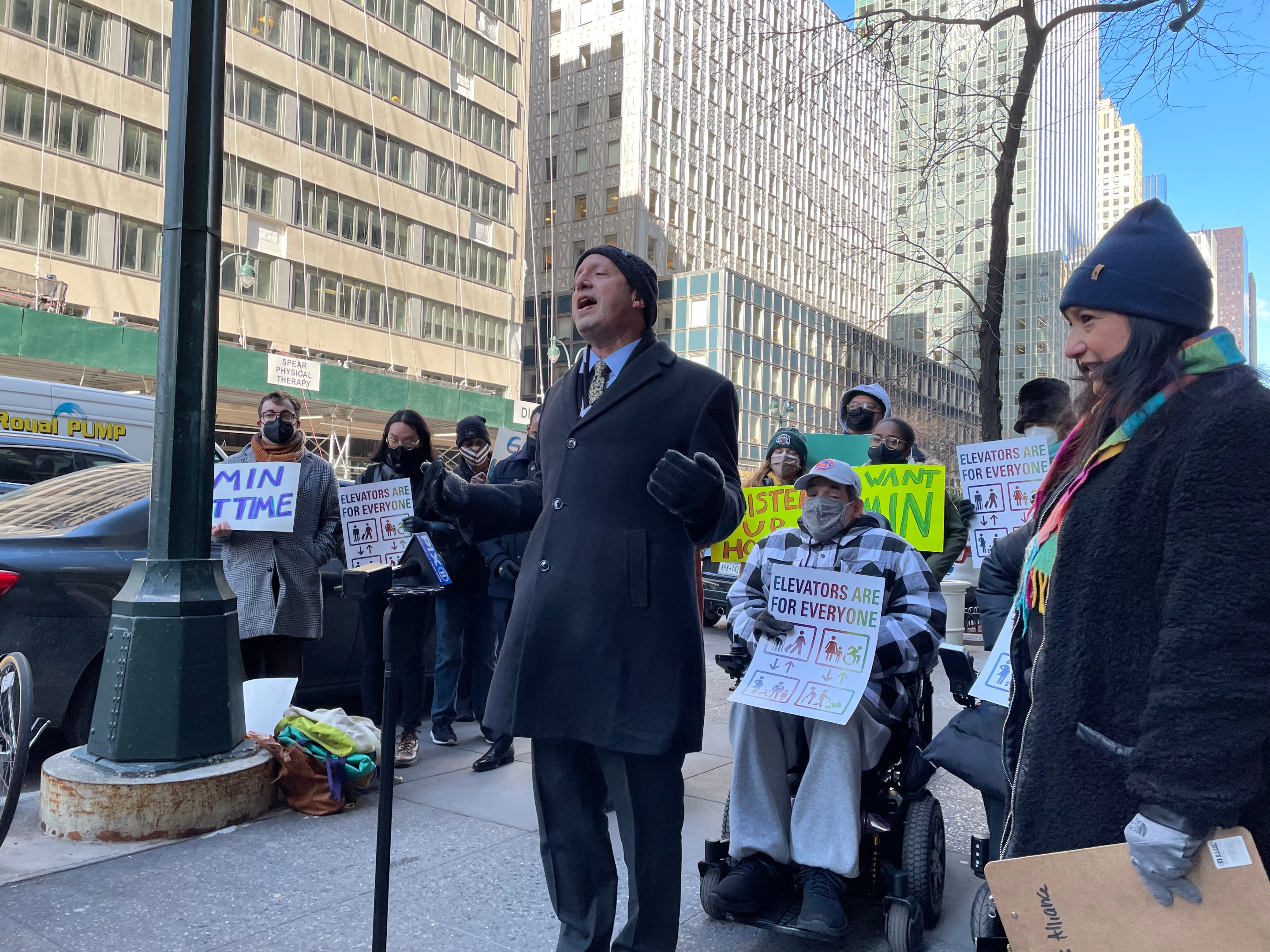Is the MTA in financial trouble or not?
Yes.
Gov. Hochul's Fiscal Year 2023 budget devotes some extra scratch to the financially strapped MTA, in the form $6.6 billion in operating aid from both state taxes and dedicated funds. That overall operating aid comes in higher than the $6.2 billion that the agency was going to receive in the Fiscal Year 2021 budget, the last state budget proposed before the coronavirus pandemic upended finances across the city and country.
The dedicated taxes, however, are not a new dedicated fund for the agency, so as ridership remains below pandemic-era swipes and the agency's top executive asks the state to fund mass transit like fire or trash pickup and not on the backs of riders, the state has to show a sense of urgency to get the essential services funding request going.
"From an organizational planning perspective, getting a dedicated revenue source up and running earlier will help them plan their service," said Reinvent Albany Senior Researcher Rachael Fauss. "It takes a long time for them to implement service changes and hire people. It's a big agency and takes money to spend money sometimes."
Hochul's budget director, and MTA Board member, Robert Mujica said in early January that the combination of federal help and a stronger state economy than once predicted is ensuring that the MTA doesn't have to rush to fill its fiscal hole, which will become a yawning gap in the final year of federal assistance in 2025.
"Right now as a result of the influx of federal dollars, we don't have an operating gap until 2025, so it gives us some time to look at the MTA," Mujica said at a press conference after Hochul released her Fiscal Year 2023 budget. "The good news for the MTA is that the dedicated taxes, just like the revenues for New York State have increased as a result of this recovery, so have they for the MTA. Our forecasts project there will be a few hundred million more in dedicated revenues than they had forecast in their November plan just three months ago. That's positive for the MTA. If those revenues continue for multiple years, it will put them in a much better position than they are today."
MTA CEO and Chairman Janno Lieber announced on Wednesday that there would be no fare hike in 2022 thanks to an additional $337 million the agency was getting this year in gas taxes and dedicated funds that fund the agency's operating side. But the MTA has also demonstrated that it has to fill its fiscal hole in 2023, 2024 and 2025, something that it was planning to do with fare hikes according to a budget presentation delivered in November 2021. Pandemic-related federal aid will cover large portions of the MTA's operating budget deficit for the next few years, as show in the orange portions of the chart below, but finally runs out in 2025, leaving the agency with a definitive $1.367 billion deficit to deal with that year.

Lieber said on Wednesday that the agency will reveal the impact of the additional subsidy money the agency is getting in its February budget plan. But the canceled fare hike means that the agency can't rely on it for revenue in 2023 or 2024, which adds additional pressure to find that elusive dedicated revenue stream. For his part, the MTA's big boss recognized there was more to ask for than just hoping the economy did better than we expected.
"We have been talking to legislature and advocacy groups and stakeholders about the need to deal with the structural deficit long before the 2025 cliff," he said on Wednesday. "So yes, it definitely did not have to be dealt with this year, but we are conveying to everybody that we expect and hope that there will start to be action on it in the next budget year."
Meanwhile, advocates rallied on Thursday to find a way to get the MTA more money, with new city Comptroller Brad Lander even reaching into his predecessor's bag of tricks for a proposal that could fund six-minute off-peak headways for the subways.
"The comptroller's office a few years ago looked at the question, what would it take to get New York City just six minute headways on all our subways and our buses," Lander said at a Riders Alliance rally on Thursday. "And the office did the analysis and found that it would actually be within our power and that it would cost about $250 million a year to achieve six minute headways on our subways and buses. What a difference that would make for people's ability to know they could get around in a timely fashion on the streets of our city."
The comptroller highlighted the plan at a rally to promote the new push from the Riders Alliance to reach in the couch cushions and find $500 million per year so the MTA can put off fare hikes for a few more years and run service every six minutes during off-peak hours. According to the advocacy organization, each ask would cost about $250 million per year. While the transit agency is flush with big ideas and big federal funding for things like the Second Avenue subway expansion and a Penn Station refurbishment, advocates pointed out that actually running the trains also takes money.
"New York State is receiving tens of billions of dollars in federal aid," said Riders Alliance Policy and Communications Director Danny Pearlstein. "We're pouring billions of dollars into Penn Station, into the Second Avenue subway, into the Interborough Express now, but riders' needs in the present moment, and rebuilding ridership, revolve around existing service. Is it affordable? Is it frequent? Is it accessible?"
Lander, who later told Streetsblog that he was not endorsing the idea as much he was talking about it, was digging up a proposal that Comptroller Scott Stringer made in his capacity as a mayoral candidate in 2021 to rejigger the way the gas tax revenues get distributed in the MTA service area. Stringer's "NYC in 6" plan was a proposal to give the majority of gas tax revenues in the 12-county MTA service area to the MTA instead of the Highway and Bridge Trust Fund.
Stringer pointed out in his pitch for the idea that the MTA only gets about 34 percent of dedicated funds coming from motor fuel taxes, petroleum business taxes, and vehicle registration fees, a revenue collective known as the Petroleum Business Tax, while another 63 percent goes towards the roads trust fund. The exact proposal was then that "within the 12-county 'metropolitan commuter transportation district,' gas taxes should be rebalanced so that roughly two-thirds of the revenue is devoted to public transit."
The MTA's February financial plan last year budgeted slightly more than $500 million from the PBT each year between now and 2024. A source in the comptroller's office said that the agency could receive about $400 million more for its operating budget if the state followed through on the NYC in 6 funding proposal, giving it close to a billion dollars a year in dedicated revenue going forward.
The proposal would need our friends in Albany to legislate the idea into reality. One lawmaker suggested that the proposal was one worth fighting for.
"I agree with the Riders’ Alliance that funding high-ridership bus routes and the subway such that transit options would be arriving every six minutes is something we need to be pushing for in New York City, and I’m supportive of any progressive way to raise the funds needed to make it happen," said state Sen. Andrew Gounardes. "The idea that Comptroller Brad Lander mentioned today — and Scott Stringer initially proposed when he was Comptroller — is certainly worth exploring. An investment in our transit is an investment in our city, and I am committed to the fight for stronger service and better funding for our subways and buses in our city."






